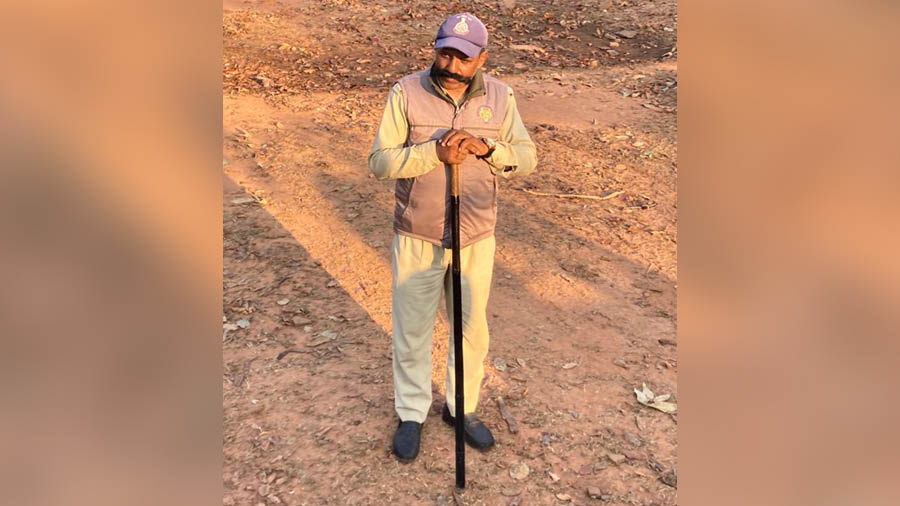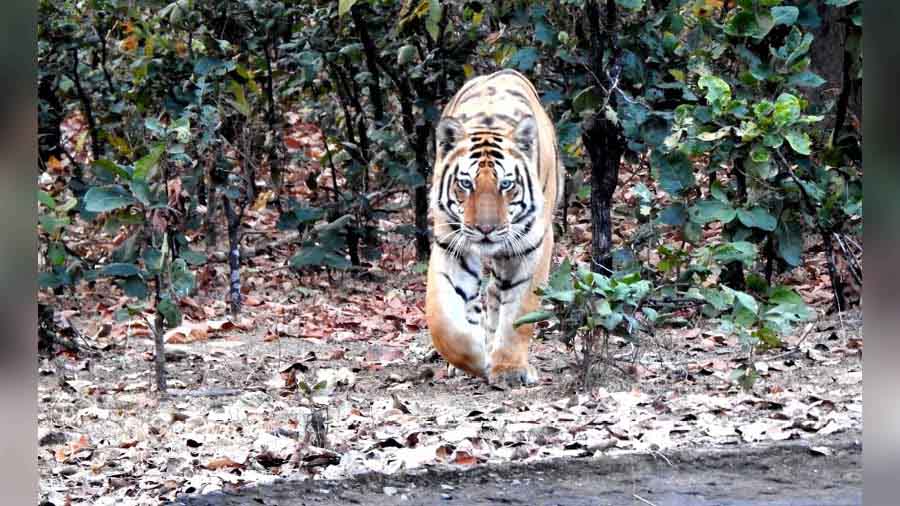Prime Minister Narendra Modi, on a recent trip to Mysuru to take part in a commemorative event for 50 years of Project Tiger, visited Bandipur Tiger Reserve but all that he spotted during the two-hour safari were a few pugmarks. The Prime Minister would perhaps do well to visit Sanjay-Dubri Tiger Reserve in Madhya Pradesh, instead, for an encounter up close with tigers.
Few have heard of the tiger reserve located in Sidhi district of Madhya Pradesh, about 200km and 250km from Allahabad and Varanasi respectively, and Sanjay-Dubri Tiger Reserve and National Park attracts the least tourists among the tiger reserves in Madhya Pradesh. But that may soon change as it is currently experiencing one of the highest frequencies of tiger-sighting in the state and the country.

A tiger clicked during a trip in March Sujata Basu
“If you consider the current tourist season, the rate of sightings is about 80 to 85 per cent in the Sanjay-Dubri forest,” said Aakash Paroha, range officer in- charge of the forest.
The tiger count at Sanjay Dubri is around 35. “So far, the annual footfall in Sanjay-Dubri has been around 5,000; while Bandhavgarh leads the footfall with around 2 lakh visitors every year, being closely followed by Kanha, Pench and Satpura tiger reserves,” said Shubha Ranjan Sen, additional principal chief conservator of forest in Madhya Pradesh.

A forest work monitoring tigers at Sanjay Dubri Subrata Ghosh
The management of Sanjay-Dubri forest has been identified as 'good' in the just- published report titled Management Effectiveness Evaluation of Tiger Reserves in India with around 73 per cent marks. "The assessment was made in 2022; we are constantly working on the management issues and expect to improve it further soon" said an official.
Though the summary report has not specifically mentioned the number of tigers in the Sanjay-Dubri forest; local officials pointed out that while the number of adults should be around 24; the number will be close to 40 if the cubs and sub-adults are included in the counting.
Local residents said on an average, around five safari jeeps enter the core of the forest during every safari slot. “Apart from the morning and afternoon shifts; there are evening-cum-night shifts as well but the latter is restricted only within the buffer zone,” said an official.
“Tourism here took off only from 2018 once Madhya Pradesh tourism opened its Parsili resort on the bank of Banas river, about 14km from the forest. This was earlier a government bungalow built to host former Prime Minister Indira Gandhi when she came here,” said an official. “Since then, four to five private accommodations have also come up,” a local resident said.
Experience of a lifetime
Several tourists from Bengal have recently visited Sanjay Dubri and spotted tigers, too.
“We went to Sanjay Dubri in the second week of March; and saw tigers from very close quarters during the safari. It was an amazing experience,” said Dulal Bose, physician and former sheriff of Kolkata.
“On one of the first two trips, we managed to see a couple of tigers from a distance; but saw several tell-tale signs of tigers roaming in the area with pugmarks everywhere we looked. However, during our third visit, we saw five tigers from very close quarters and that, too, in just a couple of hours,” said Medha Basu, a researcher from Jadavpur University, also part of the group.
“We were so close to the tigers for such a long period that few of us even clicked selfies with them,” said Sanjit Ghosh, another tourist from Bengal.
“The first sighting was exhilarating and scary as well. Our jeep was probably the first one to enter the forest and the guide was taking inputs from the forest staffers. Suddenly, we took a turn and everything around seemed to have come to a halt and there it was, a full-grown tiger right in front of the jeep!” recounted Sujata Basu, also a tourist from Kolkata.
Soma Ghosh from Kolkata visited the park during December-end and had similar experiences of sightings. “We had sightings on most of our safaris," she said.
“We saw tigers and bears and missed the leopard by a whisker,” said Subrata Ghosh, who visited the park in March.
A forest department employee, whose job is to monitor the movement of tigers, four tigresses had delivered litters about a couple of years ago and all the cubs have now grown up, leading to a spurt in the number of big cats. Moreover, three cubs that lost their mother in a train accident now stay and move around in a cluster and are often sighted,” he said.
“An abundance of beautiful saal, bamboo and thick forest all around, driving stretches full of pebbles and an expectation of seeing an animal at every turn makes the safaris unique even if you do not see a tiger,” a visitor said.

Another photograph of a Sanjay Dubri tiger Medha Basu
A future destination; but don’t let it turn into another Kanha, Bandhavgarh or Tadoba
Biswajit Roy Choudhury, an avid wildlife expert who has visited Sanjay-Dubri few times, feels the forest has the potential to become a major tiger conservation site in the country.
“It’s a beautiful forest and with several forest villages being already shifted and shifting of a few others in the pipeline, it has the potential to become the future destination of tiger conservation in the country. Already the sightings have been great in the forest,” said Roy Choudhury.
The expert, however, pointed out that the forest department should keep in mind that the tiger reserve does not become overcrowded with tourists and jeeps like several other forests.
“Sometimes, so many tourist jeeps enter the forests of Kanha, Bandhavgarh or Tadoba that tigers are forced to change their natural track and even fail to respond to the call from their partners,” said Choudhury, who pointed out the prey base in the area needs to be adequate to cater to the increasing number of tigers in Sanjay-Dubri.
Destination details
Sanjay-Dhubri Tiger Reserve and National Park Location: Sidhi district of Madhya Pradesh, near Bandhavgarh tiger reserve
Area: 831 sq. km.
Attractions: Tigers, sloth bear, chital, nilgai, chinkara, sambar, leopard, dhole, jungle cat, hyena, porcupine, jackal, fox, Indian wolf, Indian python, four-horned antelope and barking deer among others; more than 150 species of birds and few reptiles; among others
Accommodation: Parsili resort of Madhya Pradesh government, a few good private resorts have also come up
From Kolkata: Take the Shaktipunj Express. Get down at Beohari station and take a jeep to the destination, which is around 25 km away or take a flight to Varanasi or Allahabad and then take a car.
Approx cost: Monday to Friday about Rs 6,000 per car, per trip for 6 persons, including entry fee; safari jeep and guide charge; about Rs 600 more for Saturday and Sunday trips. Wednesday closed. Accommodation ranges between Rs 2,500 and 3,500.
*Contact - Either book online; or by call/WhatsApp to the tourism official of Sanjay- Dubri forest at 7440993500; or through Madhya Pradesh tourism office in Kolkata.
